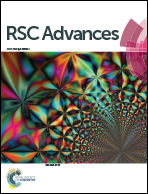The different effect of reduced graphene oxide and graphene oxide on the performance of chitosan by using homogenous fillers
Abstract
How reduced graphene oxide (rGO) and graphene oxide (GO) affect the performance of chitosan (CS) nanocomposites is discussed in this paper. A special two-step reduction method was used to prepare the CS–rGO nanocomposite films, firstly, the CS–GO nanocomposite films were prepared by the solution casting method, and secondly, the prepared CS–GO films were immersed into a reducing agent aqueous solution in which the reducing agents could diffuse onto the surface of the GO sheets and then reduce them. So this method could avoid the phenomena of aggregation, morphology change and rearrangement of the GO sheets, which would happen if they are directly reduced in the CS–GO solution with or without a surfactant. The results show that the loading of the two kinds of fillers can enhance the tensile strength of the nanocomposites, but the mechanism is different, one reason is due to the strong interfacial interaction between GO and CS, and another one may be due to the high mechanical strength of rGO and the recrystallization of the CS matrix during the reduction process. This work provides a new way to analyze the interfacial interaction between the filler and CS matrix, and also could be used in other polymer systems to find the essential mechanism of how the filler could affect on the mechanical properties of nanocomposites.


 Please wait while we load your content...
Please wait while we load your content...